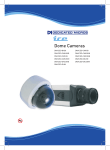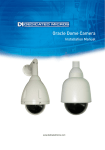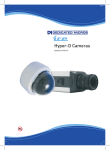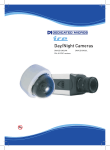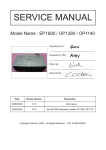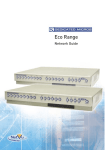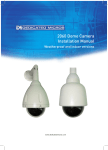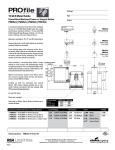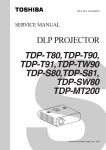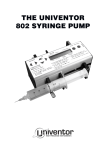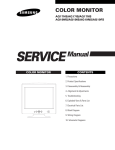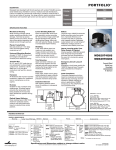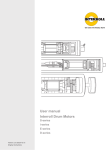Download Ice Range - Vandal Resistant Dome Camera
Transcript
Vandal Resistant Fixed Dome Cameras DM/ICEVC-BH39 DM/ICEVS-BH39 DM/ICEVS-OBH39 DM/ICEVC-CMH39 DM/ICEVS-CMH39 DM/ICEVS-OCMH39 DM/ICEVC-CMU39 DM/ICEVS-CMU39 DM/ICEVS-OCMU39 DM/ICEVC-DNU39 DM/ICEVS-DNU39 DM/ICEVS-ODNU39 Vandal Resistant Domes Contents Introduction........................................................3 Important Safeguards........................................4 Installation..........................................................5 Switch Settings..................................................8 Appendix............................................................10 Quickstart...........................................................11 Template............................................................15 Whilst every attempt is made to ensure these manuals are accurate and current, Dedicated Micros reserve the right to alter or modify the specification of the machine described herein without prejudice. Dedicated Micros ©2007 These instructions cover ICE series fixed dome cameras. Read all of these instructions. Use them to install your camera and have them available for its lifetime. If you have any problems, contact your agent. Models Mono high resolution DM/ICEDVC-BH39 DM/ICEDVS-BH39 DM/ICEDVS-OBH39 570 TVL 0.07 lux at F1.2 Ceiling mount Surface mount Surface mount with outdoor heater Vandal Resistant Colour/Mono high resolution DM/ICEDVC-CMH39 DM/ICEDVS-CMH39 DM/ICEDVS-OMH39 480 TVL 0.7 lux at F1.2 Ceiling mount Surface mount Surface mount with outdoor heater Vandal Resistant Colour/Mono ultra resolution DM/ICEDVC-CMU39 DM/ICEDVS-CMU39 DM/ICEDVS-OCMU39 540 TVL 0.7 lux at F1.2 Ceiling mount Surface mount Surface mount with outdoor heater Vandal Resistant Day/Night ultra resolution DM/ICEDVC-DNU39 DM/ICEDVS-DNU39 DM/ICEDVS-ODNU39 540 TVL 1.0 / 0.15 lux at F1.6 Vandal Resistant Ceiling mount Surface mount Surface mount with outdoor heater Vandal Resistant Domes Introduction Each model uses a 1/3” SuperHAD™ CCD. Dedicated Micros ©2007 Vandal Resistant Domes Important Safeguards Product Safety WARNING • Installation and servicing is only to be carried out by suitably qualified and experienced personnel. • Do not remove covers as there is a risk of injury or death by electric shock. • Only power low voltage dome cameras from a class 2 isolated power supply. This camera range is designed for use in general purpose CCTV applications and has no other purpose. Only operate your camera between the temperatures of -10°C and +50°C. Do not operate your camera outside its specified power supply range. Electromagnetic Compatability (EMC) CAUTION This product is intended solely for use in general CCTV applications. The product must be installed and maintained in accordance with good installation practice to enable the product to function as intended and to prevent problems. Refer to your agent for installation guidance. Declaration of Conformity The manufacturer declares that the equipment supplied with this manual is compliant with the essential protection requirements of the EMC directive 89/336 and the Low Voltage Directive LVD 73/23 EEC. Conforming to the requirements of standards EN55022 for emissions, EN61000-4 parts 2, 3, 4, 5, 6 and 11 for immunity and EN60950 for Electrical Equipment safety. Camera Care In order to avoid damaging your camera, note the following points: CAUTION • Remove all packaging inserts and the protective film from the dome cover before using the camera. • Do not touch the image surface of the sensor. If the sensor is accidentally touched, only clean it using isopropanol. • Do not expose the camera sensor to very bright light over a long period of time as this may cause damage to the CCD sensor. The camera and lens set-up must be correct to avoid possible damage due to long term exposure to bright light. A lens with an automatic iris is recommended under these conditions. Dedicated Micros ©2007 The ICE fixed dome camera is available in two versions: the ceiling mount version for installation into a ceiling tile of up to 1.5” (38 mm) thickness; and the surface mount version for installation directly onto a hard surface or mounting structure. When installing the outdoor vandal resistant dome you must set the jumpers on the thermostat PCB to the correct supply voltage being used. Parts Supplied Ceiling Mount Models Surface Mount Models 2 x Fixing screws 4 x Fixing screws 2 x Wall plugs 4 x Wall plugs 2 x Machine screws 4 x O-rings 2 x Sprung toggle clips Custom torx key Custom torx key This booklet This booklet Parts Not Supplied • Optional video service lead (part number DM/ICED-SERV) Ceiling Mount Installation Vandal Resistant Domes Installation Refer to the Quickstart section for more information. 1 2 3 4 5 6 7 8 Loosen the two torx screws on the front of the camera using the torx screw key supplied. Gently pull away the dome cover from the camera body and remove the plastic shroud. The dome cover is attached to the camera body with a retaining cord. Do not undo or cut this cord. Using the template supplied at the rear of this booklet, mark and drill two 5/8” (16 mm) holes at opposite sides of the large hole. Mark and cut a 4” (100 mm) diameter hole. Check that the holes are large enough to enable the safety lugs on the camera body to pass through. Mark and drill the two screw holes for fixing the camera body. Two pairs of screw holes are provided on the camera body for ease of fixing. Use only one pair of screw holes. A 5 mm drill bit is suitable for use with the supplied wall plugs. Connect the video cable to the BNC connector at the end of the flying lead or directly to the BNC connector on the camera body. Use only one of the BNC connectors to connect the video cable. Connect the power cable to the power terminals. The camera operates from a 12V DC or 24V AC power supply. Connections and polarity are indicated next to the terminals. The power supply must be a UL Listed, Class 2 isolated type. Optionally attach a safety chain (not supplied) to one of the lugs and secure the other end of the safety chain to a fixed object. Insert the camera body into the hole and fix it to the ceiling tile using either the wood screws and wall plugs supplied or the two machine screws and sprung toggle clips. Do not over-tighten the screws. Optionally attach a local monitor to the test point using an DM/ICED-SERV service connector (available separately) and adjust the camera as described earlier. Visually align the screws on the dome front cover with the screw holes on the camera body to assist in replacing the dome cover. Replace the dome front cover and tighten the torx screws, taking care not to trap the retaining cord in the edge of the front cover. Do not over-tighten the torx screws. Dedicated Micros ©2007 Vandal Resistant Domes Note: This dome uses non standard Torx screws for increased security, which can only be unfastened using the provided tool. Surface Mount Installation Refer to the Quickstart section for more information. Video and power cables enter the camera body inside a plastic or metal conduit either from the side or rear of the camera. 1 Loosen the four torx screws on the front of the camera using the torx screw key supplied. 2 Gently pull away the dome cover from the camera body and remove the plastic shroud. The dome cover is attached to the camera body with a retaining cord. Do not undo or cut this cord. 3 Unscrew one of the two large screws, either at the side or rear of the camera body, depending on where the video and power cables are to enter the camera body. Note that the screw is wrapped in PTFE tape. This is necessary to ensure that moisture does not enter the camera body after the camera has been installed. 4 Using the template supplied at the rear of this booklet, mark and drill the four screw holes required for fixing the camera body. An 8 mm drill bit is suitable for use with the supplied wall plugs. Note: If the video and power cables enter from the side of the camera, you may wish to fit a conduit in position temporarily at the side of the camera to align the camera before marking the screw holes. If the video and power cables enter from the rear of the camera, mark and drill a hole for the conduit and leads. The size of hole required depends on the size of the conduit. The template shows the position of the large screw hole at the rear of the camera. 5 Attach a metal or plastic conduit with a suitable M20 screw thread to the side or rear entry point using PTFE tape to ensure a watertight seal. Ensure that the conduit does not foul the plastic camera mount inside the camera body. 6 Screw the camera body to the fixing surface using the screws, wall plugs and o-rings supplied. O-rings must be used to ensure that moisture does not enter the camera body after the camera has been installed. Do not over-tighten the screws. 7 Connect the video cable to the BNC connector at the end of the flying lead. Connect the power cable to the power terminals. The camera operates from a 12V DC or 24V AC power supply. Connections and polarity are indicated next to the terminals. The power supply must be a UL Listed, Class 2 isolated type. 8 Optionally attach a local monitor to the test point using an DM/ICED-SERV service connector (available separately) and adjust the camera as described earlier. 9 Visually align the screws on the dome front cover with the screw holes on the camera body to assist in replacing the dome cover. 10 Replace the dome front cover and tighten the torx screws, taking care not to trap the retaining cord in the edge of the front cover. Do not over-tighten the torx screws. Note: This dome uses non standard Torx screws for increased security, which can only be unfastened using the provided tool. Dedicated Micros ©2007 Camera Position The camera assembly is adjustable in all three axes. Adjust the camera until it is pointing in the desired direction. FOV & Focus Use the levers on the varifocal lens to adjust the camera’s field of view, and focus. Dedicated Micros ©2007 Vandal Resistant Domes Camera Adjustment Vandal Resistant Domes Switch Settings The DIP switches are located on the camera’s circuit board. Switch Function 1 Backlight Compensation 2 Automatic Gain Control 3 Electronic Iris 4 Line Lock Switch Function 1 Day/Night 2 Colour Burst OFF ON INT LL OFF ON HI LO Default setting White indicates switch position Backlight Compensation The Backlight Compensation (BLC) feature compensates for back-lit scenes by enhancing objects in the centre of the scene which would previously have been in silhouette. Select ON or OFF using the BLC switch. Default is OFF. AGC (Automatic Gain Control) The Automatic Gain Control (AGC) feature can improve picture quality when levels of illumination are low. Select ON or OFF using the AGC switch. For most applications the AGC feature should be ON and is therefore the default setting. Electronic Iris The Electronic Iris (EI) feature compensates for excessive light levels by automatically adjusting the shutter speed. For auto-iris lenses, the EI should be set to OFF. For manual lenses, EI should be ON. Line Lock Choose INT (internal) or LL (adjustable). The LL setting allows ±180° phase adjustment via the two LL Phase Advance/Retard buttons. Default is LL. Pressing both buttons simultaneously will reset LL to the factory default setting. The LL setting can be adjusted using the LL potentiometer available on some versions of this product. Dedicated Micros ©2007 (DN Versions only) This switch sets the light level at which the camera automatically switches between day and night operation. Hi sets the camera to switch between day and night mode at higher light level. Lo sets the switching point at a lower light level. The default setting is Lo. When in Night mode, the IR cut filter is removed allowing infra red illumination to be used. Colour Burst (DN versions only) The Colour Burst (CB) switch allows the colour burst component of the signal to be turned on or off. When a day/night camera switches to night (mono) mode, the colour burst can be switched OFF for a true monochrome signal. Note that some multiplexers/recorders detect video-loss if the colour burst signal disappears. If problems are encountered with the multiplexer/recorder when the camera switches to mono, try setting CB to ON. Default is CB OFF. Lens Level Adjust the lens iris level according to the lighting conditions. 1 2 3 Turn the Automatic Gain Control switch OFF Adjust the Lens Level potentiometer so that a 1 V peak-to-peak signal is achieved. Use care so as not to damage the potentiometer. Turn the Automatic Gain Control switch ON Vandal Resistant Domes Day/Night Local Video Out Provision is made for the connection of a local video monitor to assist in setting up the camera. Use the optional service connector DM/ICED-SERV (not supplied). Final Assy When all the connections and adjustments have been made, re-attach the camera liner and dome cover. Dedicated Micros ©2007 Vandal Resistant Domes Appendix Dimensions VC version A 112 mm 4.41" 160 mm 6.30" 160 mm 6.30" 96 mm 3.78" 66 mm 2.60" B 104 mm 4.09" 95 mm 3.74" 148 mm 5.83" 148 mm 5.83" 55 mm 2.17" VS version 10 Dedicated Micros ©2007 VS VERSIONS Dedicated Micros ©2007 Vandal Resistant Domes Quickstart 11 Vandal Resistant Domes 12 Dedicated Micros ©2007 VC VERSIONS Dedicated Micros ©2007 Vandal Resistant Domes Quickstart 13 Vandal Resistant Domes 14 Dedicated Micros ©2007 Vandal Resistant Domes Template Pattern for VC Ceiling Dome ) 6” 9 /1 (4 m 10 0m m 4m 11 (4 ”) 5mm(3/16”) 16mm(5/8”) NOT TO SCALE Pattern for VS Ceiling Dome 15mm 57mm ø8mm mm 70 NOT TO SCALE 0m 10 m Dedicated Micros ©2007 15 Dedicated Micros Ltd. 1200 Daresbury Park, Daresbury, Cheshire, WA4 4HS, UK Dedicated Micros Europe Neckarstrafle 15, 41836 Hückelhoven, Germany Dedicated Micros USA. 23456 Hawthorne Blvd. Suite 100, Torrance, CA 90505, USA Dedicated Micros France 9-13 rue du Moulinet 75013 Paris, France Dedicated Micros, Australia PTY. 5/3 Packard Avenue, Castle Hill, NSW 2154, Australia Dedicated Micros Slovenia Delavska cesta 26, 4208 Sencure, Slovenia Dedicated Micros, Asia PTY 16 New Industrial Road, #03-03 Hudson Techno Centre, Singapore 536204 Dedicated Micros Benelux Joseph Chantraineplantsoen 1, 3070 Kortenberg, Belgium Dedicated Micros Middle East Building 12, Suite 302, P.O. Box 500291, Dubai Internet City, Dubai, United Arab Emirates Dedicated Micros USA. 14434 Albemarle Point Place, Suite 100, Chantilly, Virginia 20151 USA Dedicated Micros (Malta) Ltd. BLB017, Bulebel Industrial Estate, Zejtun, ZTN08, Malta MI-I-ICEVR/E1-0
















